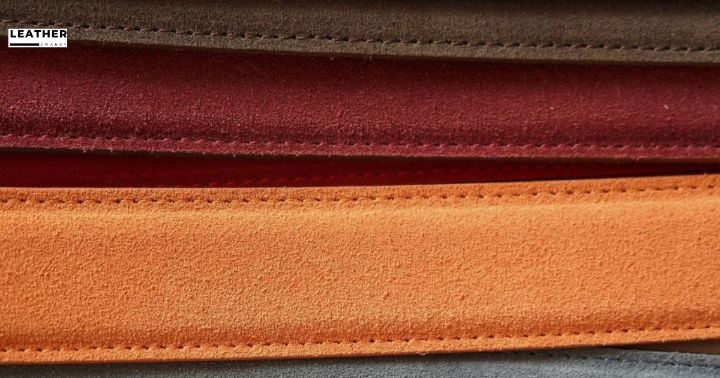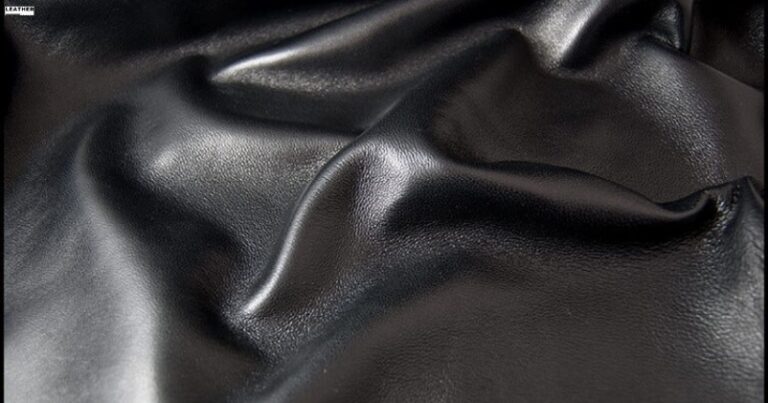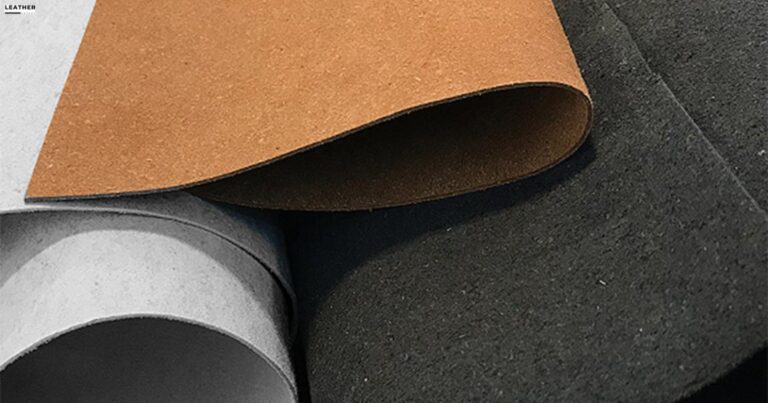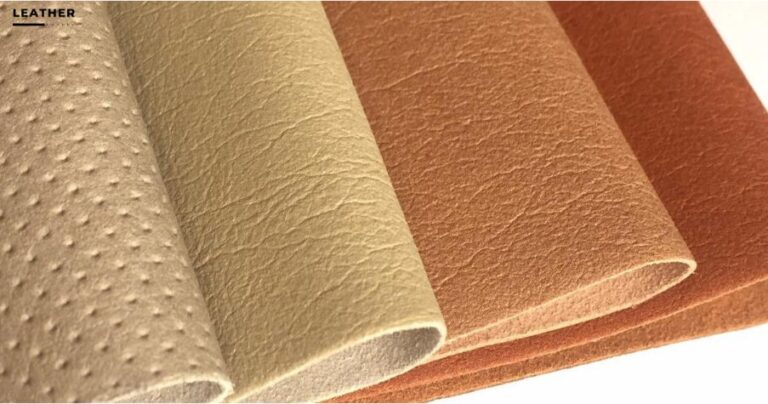Vegetable Tanned Leather Vs Chrome Tanned Leather
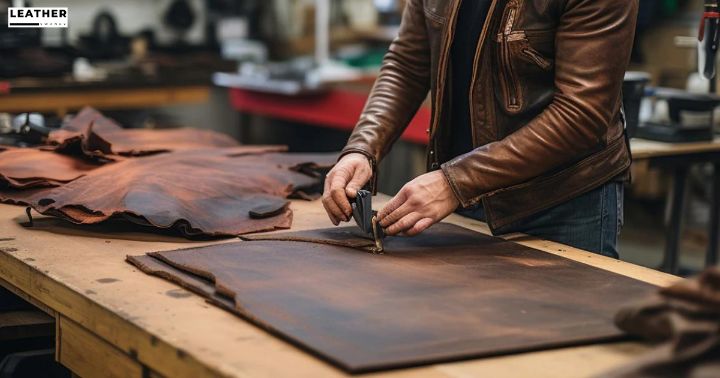
Are you looking to learn more about vegetable tanned leather vs chrome tanned leather? If so, you’ve come to the right place.
In this article, we’ll cover a range of topics related to these two types of tanning such as what they are, their pros and cons, cost and availability comparisons, how to distinguish them from each other, and which is the best option.
Jump to a Specific Section
- 1 Key Takeaways
- 2 What Exactly is Tanning?
- 3 What Is Leather Tanning?
- 4 What Is Vegetable Tanned Leather?
- 5 What Is Chrome Tanned Leather?
- 6 Pros and Cons of Vegetable Tanned Leather
- 7 Pros and Cons of Chrome-Tanned Leather
- 8 Comparing the Cost and Availability of Vegetable Tanned Leather Vs Chrome Tanned Leather
- 9 How Do You Distinguish Chrome Tanned Leather from Vegetable Tanned Leather
- 10 Vegetable Tanned Leather Vs Chrome Tanned Leather? Which is the Best Option?
- 11 Additional Tips and Tricks
- 12 Conclusion
- 13 Frequently Asked Questions
- 13.1 How Long Does It Take to Tan Leather Using Vegetable Tanning?
- 13.2 How Does Vegetable Tanning Compare to Chrome Tanning in Terms of Durability?
- 13.3 What Is the Difference in Color Between Vegetable Tanned Leather and Chrome Tanned Leather?
- 13.4 Is It Possible to Re-Tan Vegetable Tanned Leather?
- 13.5 Are There Any Alternatives to Vegetable Tanning or Chrome Tanning?
- 13.6 What is the difference between vegetable-tanned leather and chrome-tanned leather?
- 13.7 How is vegetable-tanned leather made?
- 13.8 How is chrome-tanned leather made?
- 13.9 Which tanning process is more environmentally friendly?
- 13.10 Is vegetable-tanned leather better than chrome-tanned leather?
- 13.11 Is vegetable-tanned leather softer than chrome-tanned leather?
- 13.12 Is chrome-tanned leather superior to vegetable-tanned leather?
- 13.13 What are the benefits of chrome-tanned leather?
- 13.14 Can I get vegetable-tanned leather if I prefer chrome-tanned leather?
- 13.15 Is chrome-tanned leather also considered to be quality leather?
- 14 Resources Used for Research
Key Takeaways
- Vegetable-tanned leather is strong, durable, and eco-friendly, while chrome-tanned leather is soft, durable, and considered real leather.
- Vegetable-tanned leather develops a natural patina over time and enhances the natural grain of the hide, while chrome-tanned leather has a uniform finish and offers a wide range of colors and textures.
- Vegetable-tanned leather is more expensive to produce and has a longer lifespan, while chrome-tanned leather is more affordable and widely available.
- Vegetable tanning uses natural materials and has a lower ecological impact, while chrome tanning relies on chemically intensive agents and produces more waste and pollution.
What Exactly is Tanning?
Tanning is the process of treating animal hides and skins to make them more durable, and it’s something you should be aware of when considering different types of leather. Leather tanning involves a variety of chemicals that are used to preserve the hide, making it supple and resistant to decay.
The two most common types of leather tanning are vegetable-tanned leather and chrome-tanned leather. Vegetable-tanned leather (also known as veg-tan leather) uses natural tannins found in plants such as oak or chestnut bark which helps create a soft, pliable material.
Chrome-tanned leather uses chromium salts for preservation instead, resulting in a much harder texture that wears better over time. Understanding how these processes work can help you decide which type of tanning is best suited for your needs.
With this knowledge, you can confidently choose between the two popular types of tanning, vegetable-tanned leather and chrome-tanned leather based on their specific characteristics and what will work best for your project.
What Is Leather Tanning?
Tanning is the process of treating hides or skins to make them suitable for use in products like clothing and accessories. Leather tanning is a complex process that requires specialized skills, knowledge, and equipment.
It involves selecting the right hide or skin, then preparing it so it can be worked with. The two main types of leather tanning are vegetable tanning and chrome tanning.
Vegetable-tanned leather has been treated with natural substances such as tree bark while chrome-tanned leather has been treated with chemicals such as chromium salts. Knowing how to tell the difference between vegetable-tanned leather and chrome-tanned leather will help you decide which type best suits your needs.
While both offer durable and long-lasting results, each has its own unique properties that could affect the longevity of your product. With this knowledge, you’ll be able to choose wisely when making your purchase.
As you can see, understanding the differences between vegetable-tanned leather vs chrome tanned leather is essential if you want to make an informed decision about which type of material is best for your project.
What Is Vegetable Tanned Leather?
Vegetable-tanned leather is an age-old process used to create real leather products. It involves using natural ingredients like tree bark and leaves to produce the desired leather.
This process yields a product that is strong, durable, and eco-friendly. Vegetable tanning produces a unique type of leather that many people prefer due to its natural color, durability, and the fact that it does not require harsh chemicals for production.
How is Vegetable Tanned Leather Produced?
Producing vegetable-tanned leather involves using natural substances, such as tree bark or other plant materials, to tan the hide. The process begins by soaking the rawhide in a mixture of water and tannin-rich plant material for several days.
This causes the proteins in the hide to become more stable and resistant to decay. Once this is done, the leather is removed from the solution and transferred to a tannery where it can be dyed and finished with oils and waxes.
Vegetable tanning processes are time-consuming due to their dependence on natural ingredients, but they create a product that is considered more authentic than chrome-tanned leathers.
Additionally, veg-tan leather will develop an attractive patina over time that increases its value. With proper care, veg-tanned leather can last many years while remaining beautiful and durable.
Is Vegetable Tanned Leather Real Leather?
Yes, vegetable-tanned leather is real leather and you’ll notice the difference in quality compared to chrome-tanned leather. Tanning is an important part of how a hide becomes usable for a variety of purposes.
Vegetable tanning uses natural tannins derived from plants while chrome tanning uses chromium salts. The table below illustrates the differences between these two processes:
| Process | Vegetable Tanning | Chrome Tanning |
|---|---|---|
| Chemicals used | Natural tannins from plants such as chestnut and quebracho trees, oak bark, etc. | Chromium salts (usually trivalent chromium) |
| Impact on Environment | Minimal since it doesn’t use harsh chemicals or produce toxic byproducts during processing. | Can be damaging as it produces hazardous byproducts that can pollute the environment. |
| Quality of Leather Produced | Softens with time; more durable; develops patina and character over time. | Consistent color; not very breathable; prone to cracking and fading quickly over time. |
Ultimately, vegetable-tanned leather better meets people’s expectations for what exactly is tanning and how it should be done correctly without harming the environment or compromising on quality.
As a result, this type of leather has been growing in popularity for its eco-friendly production process and superior product characteristics compared to chrome-tanned products.
By understanding how each type of tanning works, consumers can make more informed decisions when purchasing their favorite items made with genuine leather materials.
What Is Chrome Tanned Leather?
Chrome-tanned leather is a type of leather produced by tanning the hide with chromium salts. This method of tanning is quite different from vegetable tanning, and it’s important to understand what that difference is when shopping for real leather.
In terms of production, chrome-tanned leather uses chromium salts to turn animal hides into a soft durable material, so yes chrome-tanned leather can be considered real leather.
How is Chrome Tanned Leather Produced?
To make chrome-tanned leather, chemicals are used in the tanning process instead of vegetable-based materials. The chrome tanning method can be separated into 6 steps:
- Soaking the hides to remove dirt and oils
- Liming to break down proteins for easier hair removal
- Unhairing by scraping or using a chemical bath
- Bating with enzymes to soften the hide
- Tanning with chromium salts which penetrate into the hide fibers
- Finishing with dyeing, oiling, greasing, and polishing The result is an even-colored leather that is highly resistant to water damage, much more so than vegetable-tanned hides.
However, it takes longer for this type of leather to develop character over time like vegetable-tanned leather does due to its tight fibers and uniform finish.
Chrome-tanned leather is real leather; it just undergoes a different tanning method than vegetable-tanned hides do.
Is Chrome Tanned Leather Real Leather?
Yes indeed, chrome-tanned leather is still real leather, just produced using a different method than vegetable-tanned hides. To understand why it is considered to be real leather, one must understand the tanning process that all leather must go through in order to become usable.
Tanning gives the hide its desired durability and flexibility while also preserving it from decay and water damage. Chrome-tanned leather simply uses chromium salts instead of vegetable-based ingredients for the tanning process.
This makes it less expensive to produce while still providing many of the same benefits as traditional vegetable tanning such as strength and suppleness – perfect for making things like leather belts.
Despite being made differently, chrome-tanned leather is undeniably real. Therefore, when considering which type of leather to invest in, there’s no need to worry about whether or not you’ll get your money’s worth with chrome-tanned hides.
Pros and Cons of Vegetable Tanned Leather
You might be wondering about the pros and cons of vegetable-tanned leather. It is important to understand the differences between vegetable-tanned leather and chrome-tanned leather in order to make an informed decision when purchasing a product made from either material.
In this discussion, we will look at the advantages and disadvantages of vegetable tanning so you can decide which type of leather best meets your needs.
Pros
You’re sure to appreciate the pros of vegetable-tanned leather, such as its natural look and feel its breathability, and its environmental friendliness. Here are some advantages of using vegetable-tanned leather over chrome tan leather:
- It develops a beautiful patina that is unique to each product
- It has a more natural scent than chrome-tanned leather
- It’s considered more environmentally friendly since it doesn’t contain any potentially hazardous chemicals or heavy metals
- Its flexibility allows for a greater range of use in different applications.
Vegetable-tanned leather has many benefits compared to chrome-tanned options; however, there are also some drawbacks that should be taken into consideration.
Cons
So you know the pros of veg-tanned leather, but what about the cons? Vegetable tannin can be expensive to produce and is not as widely available as chrome-tanned leather.
Veg-tanned leather also takes much longer to produce than chrome-tanned leather, which means it’s more costly in terms of both time and money.
Additionally, vegetable-tanned leather has a negative environmental impact because it produces harmful chemicals that can pollute water sources.
This is why many companies are now turning to alternative tanning methods that have less of an environmental impact. So while there certainly are drawbacks to veg-tanned leather, the benefits still make it an attractive option for many consumers.
Pros and Cons of Chrome-Tanned Leather
Chrome-tanned leather is a type of leather that has been treated with chromium salts to produce a strong, flexible, and waterproof material. It’s an attractive choice for many due to its durability and affordability, but there are both pros and cons to consider when making the decision whether or not to use chrome-tanned leather.
In this discussion, we’ll explore the advantages and disadvantages of this popular tanning process.
Pros
Vegetable-tanned leather has many pros, such as being environmentally friendly and durable. Here are the main benefits:
- It is more eco-friendly than chrome-tanned leather, as it doesn’t require toxic chemicals to tan the hide.
- The texture of vegetable-tanned leather can be manipulated with the use of dyes and finishes, giving you a wide range of colors and textures to choose from. -It’s also much more durable than chrome-tanned leather due to its high oil content. The process used for vegetable tanning also enhances the natural grain of the hide, making it look luxurious and elegant. However, these advantages come at a cost; vegetable tanning is slower and more labor-intensive than chrome tanning.
Cons
Unfortunately, vegetable-tanned leather can be more expensive than chrome-tanned leather due to its slower and more labor-intensive process.
The Vegetable tanning process uses natural materials such as tree bark or leaves to tan the hide, rather than Chrome tanned which uses a chemical-based tanning solution.
This makes vegetable-tanned leather much less accessible, as it requires specific resources that may not be available in certain areas or climates.
Additionally, the curing time for vegetable-tanned hides is significantly longer than chrome-tanned hides up to months compared to days making it less cost-effective for large production orders.
As a result, the overall availability of vegetable-tanned leather is much lower than chrome-tanned leather. Thus, weighing the cost and accessibility of these two types of Leather should be taken into consideration when deciding which type of Leather is best for your needs.
Comparing the Cost and Availability of Vegetable Tanned Leather Vs Chrome Tanned Leather
Comparing the cost and availability of vegetable-tanned leather vs chrome-tanned leather, you’ll find that one might be more easily accessible than the other.
Generally speaking, vegetable-tanned leather is cheaper and more widely available than chrome-tanned leather due to its popularity. Here are some key differences between the two:
- Cost: Vegetable-tanned leather is typically less expensive than chrome tanned.
- Availability: Chrome-tanned leather is usually harder to source compared to vegetable tanned.
- Durability: Vegetable tanned tends to be more durable than chrome tanned because it has a longer life span.
- Color: Chrome tanning produces a brighter color while vegetable tanning produces a darker hue.
These factors can help you distinguish between vegetable and chrome-tanned leathers, making it easier to decide which type of material best fits your needs.
Ultimately, understanding the difference between these types of leather will help you make an informed decision when shopping for quality materials that fit your budget and style requirements allowing you to move seamlessly onto distinguishing chrome from vegetable-tanned leathers.
How Do You Distinguish Chrome Tanned Leather from Vegetable Tanned Leather
Knowing how to tell the difference between chrome-tanned and vegetable-tanned leathers can be tricky, but it’s important to understand both types in order to make an informed purchase. The two materials are distinguished by the type of tanning process used on animal skin.
Vegetable-tanned leather is produced through processes that use natural ingredients such as tree bark and other plant matter, while chrome-tanned leather uses chromium salts sourced from mineral deposits.
| Vegetable Tanned | Chrome Tanned |
|---|---|
| Natural Ingredients | Chromium Salts |
| Longer Tanning Process | Shorter Tanning Process |
| Less Durable Finish | More Durable Finish |
The most obvious difference is in the color; vegetable-tanned leather has a more natural hue, whereas chrome-tanned leather usually has a brighter finish.
Also, vegetable-tanned material may have a stronger smell due to its organic components being exposed to heat during production.
Finally, this type of leather tends to age gracefully over time and develop a unique patina when exposed to sunlight or moisture. Ultimately, knowing these distinguishing characteristics will help you decide which type of leather is right for your needs.
Vegetable Tanned Leather Vs Chrome Tanned Leather? Which is the Best Option?
When it comes to choosing between vegetable and chrome-tanned leather, it can be difficult to decide which is best. Here are some factors to consider when making the decision:
- Patina – Vegetable-tanned leather develops a natural patina over time, creating a unique look that many people prefer. Chrome-tanned leather will not develop this patina as easily or naturally but can still be manipulated with dyes and treatments for a desired effect.
- Mimosa Tanning Agent – Vegetable tanning uses natural sources like mimosa and chestnut for its tanning agent, whereas chrome-tanned leather relies on more chemically intensive tanning agents in its production process.
- Salt – The amount of salt used during the tanning process affects how much water is retained in the hide; vegetable-tanned hides retain more moisture than their chrome counterparts, meaning they may be softer and more flexible than chrome-tanned leathers.
- Cost – Chrome-tanned leather tends to cost less than vegetable-tanned leather overall due to its quicker production time and fewer ingredients needed in its production process.
No matter which type you choose, understanding the differences between the two types of tanning processes will help you make an informed decision about your next purchase.
Additional Tips and Tricks
If you’re in the market for leather, there are a few other tips and tricks to keep in mind. Vegetable tanning is a process that uses natural tannins from tree bark and other plants to transform hides into leather.
Chromium salts are utilized during the chrome tanning process, which creates more flexible leather than vegetable-tanned leather. Consider your intended use of the leather when selecting between these two processes as each offers benefits depending on its application.
Vegetable-tanned leather tends to be stiffer and may be better suited for items such as belts, watch straps, or saddles; whereas chrome-tanned leather is softer and can work better for upholstery, shoes, or bags.
Both processes can also impart different colors onto the hide – vegetable tanning will produce earthy tones while chrome tanning will offer brighter hues.
It’s important to remember that both processes have their own unique characteristics so it pays to research their individual uses before making a decision on which type of tanning process best suits your needs.
Conclusion
Ultimately, when it comes to vegetable-tanned leather vs chrome-tanned leather, the choice is yours. Both have their advantages and disadvantages, so you need to carefully consider what type of leather best suits your needs.
Consider the cost, availability, and characteristics of each type before making a decision. With a bit of research and experimentation, you can easily find the best option for your project.
Frequently Asked Questions
How Long Does It Take to Tan Leather Using Vegetable Tanning?
It typically takes 5-6 weeks to tan leather with vegetable tannins. You need to prepare the hide, then soak it in a solution of natural ingredients, before allowing it to dry and cure. The process can be lengthy but yields a durable and unique product.
How Does Vegetable Tanning Compare to Chrome Tanning in Terms of Durability?
Vegetable tanning is generally more durable than chrome tanning, as it creates a firm and strong leather. Chrome-tanned leather can be much softer but doesn’t have the same level of longevity.
What Is the Difference in Color Between Vegetable Tanned Leather and Chrome Tanned Leather?
You’ll notice a distinct difference in the color of vegetable-tanned and chrome-tanned leather. Vegetable-tanned has a more natural, yellowish hue while chrome-tanned is typically brighter and more saturated.
Is It Possible to Re-Tan Vegetable Tanned Leather?
Yes, it is possible to re-tan vegetable-tanned leather. It involves stripping the existing tanning material and adding new materials to give the leather a different look and feel. The process can be time-consuming and requires special attention to detail in order to achieve desired results.
Are There Any Alternatives to Vegetable Tanning or Chrome Tanning?
Yes, there are alternatives to vegetable and chrome tanning. Brain tanning and bark tanning are two options used by some leather workers. Both methods use natural processes that create a unique finish.
What is the difference between vegetable-tanned leather and chrome-tanned leather?
Vegetable-tanned leather and chrome-tanned leather are two different types of leather that are made through different tanning processes.
How is vegetable-tanned leather made?
Vegetable-tanned leather is made using natural tannins derived from plants such as tree bark. This tanning process is more traditional and time-consuming compared to chrome tanning.
How is chrome-tanned leather made?
Chrome-tanned leather is made using chromium salts, specifically chromium sulfate. This tanning process takes less time and is more commonly used in modern leather production.
Which tanning process is more environmentally friendly?
Vegetable tanning is considered to be more environmentally friendly compared to chrome tanning. This is because vegetable tanning uses natural tannins and does not require the use of harmful chemicals.
Is vegetable-tanned leather better than chrome-tanned leather?
The choice between vegetable-tanned leather and chrome-tanned leather depends on personal preference and specific needs. Both types of leather have their own advantages and disadvantages.
Is vegetable-tanned leather softer than chrome-tanned leather?
Yes, vegetable-tanned leather is generally thinner and softer than chrome-tanned leather. This makes it more suitable for certain applications, such as making leather goods that require flexibility.
Is chrome-tanned leather superior to vegetable-tanned leather?
Chrome-tanned leather is known for its durability and resistance to water, making it suitable for certain applications such as leather boots. However, vegetable-tanned leather is often preferred for its natural look and feel.
What are the benefits of chrome-tanned leather?
Chrome-tanned leather offers advantages such as increased durability, water resistance, and the ability to retain its shape over time. It is also more readily available and cost-effective.
Can I get vegetable-tanned leather if I prefer chrome-tanned leather?
Yes, it is possible to find products made with vegetable-tanned leather even if you prefer chrome-tanned leather. Some manufacturers offer customization options and can accommodate specific requests.
Is chrome-tanned leather also considered to be quality leather?
Yes, chrome-tanned leather is still considered to be quality leather. It has its own unique properties and is widely used in the leather industry for various purposes.
Resources Used for Research
Leather Processing, Its Effects on Environment and Alternatives of Chrome Tanning

